[From Quiggin's Guide, 1841]
[Ramsey]
Returning to Kirk Patrick church, and taking the main road you
very soon arrive at Ballamore, the property of Mr. Richardson. Here
is occular proof that timber of every description will grow on the
Island if properly cultivated. A little beyond
Ballamore, on the right, is the residence of the Rev. T. Stephen,
beyond which is Ballacosnahan, Mrs. Gelling, and Ash Lodge, Miss St.
John.
Arriving a second time at the Tynwald Mount, you proceed on the
route for Ramsey, by taking the left hand road when you come to the
four cross ways, the first part of which, for about two miles, lies
through a deep and solitary glen. It is a most hermit-like solitude;
steep, lofty, barren, and desolate. In the bottom runs a narrow
rivulet, above which the road is cut on the side of the hill. A
little distance from the main road is the romantic and beautiful
cascade of Rhenass, which leaps down the mountain from whence it
takes its origin, till it approaches the last and steepest stage,
from whence with much rapidity it casts itself into the vale below.
The fall is from a considerable height, and its picturesque beauty
and wild melody receive an additional effect from the solitude of the
surrounding scenery. The spot is difficult to be found, but a guide
may be obtained at the watering house at the foot of the hill.
After ascending a tiresome hill, upwards of a mile in length, the
country appears more humanized, and continues to improve until you
arrive at the pleasant village of Kirk Michael; at the entrance is
the Mitre Tavern, kept by Mr. Gee, near to which is a small and neat
court-house, wherein the Consistory court is held the last Thursday
in every month, and in which the northern Deemster occasionally
transacts business. This village is rendered interesting as having
been the home scene of Bishop Wilson’s active benevolence for
half a century, and no one will surely pass through it without paying
a visit to the earthly remains of so much excellence. The church is
in the midst of the village. This is a newly erected building, the
expense of which was mostly defrayed by funds collected in England
for the purpose.
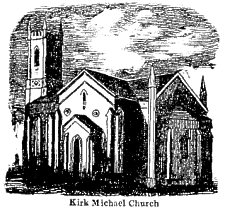 In
the church yard the first thing that attracts attention is a plain
tomb, railed in with iron, on which is the following inscription:
"Sleeping in Jesus: here Lyeth the Body of Thomas
Wilson, D. D., Lord Bishop of this Isle, who Dyed March the 7th,
1755, aged 93, and in the 58 Year of his Consecration. This Monument
was Erected by his Son Thomas Wilson, D.D., a Native of the Parish,
Who in obedience to the express Commands of his worthy Father,
Declines giving him the Character He so Justly Deserved. Let this
Island Speak the Rest." Bishop Hildersley, Phillips, Mason, and
Crigan are also buried in this church yard, where are many reliques
of great antiquity, amongst them is a stone cross with the following
inscription :—
In
the church yard the first thing that attracts attention is a plain
tomb, railed in with iron, on which is the following inscription:
"Sleeping in Jesus: here Lyeth the Body of Thomas
Wilson, D. D., Lord Bishop of this Isle, who Dyed March the 7th,
1755, aged 93, and in the 58 Year of his Consecration. This Monument
was Erected by his Son Thomas Wilson, D.D., a Native of the Parish,
Who in obedience to the express Commands of his worthy Father,
Declines giving him the Character He so Justly Deserved. Let this
Island Speak the Rest." Bishop Hildersley, Phillips, Mason, and
Crigan are also buried in this church yard, where are many reliques
of great antiquity, amongst them is a stone cross with the following
inscription :—
"ULEIFAN FUENTRE GUDAN NOM ILEAN RENTI CRUND: SON SFSTR MEL WUTUR
FUNTRE MUS TOLIRLUF CETLAN CONE IN E."
This ancient Cross which cannot but be highly interesting to every
Antiquary, contains the most perfect specimen of the Runic character,
to be found, perhaps in her Majesty’s dominions. And just by the
church yard gate is another runic pillar of blue stone, curiously
sculptured, from the base to the summit, with devices singularly
involved with each other, and bearing the following
inscription:—
"JUALFTR:! UJNR: THURULF!: EIN!: RAUTHA: RI TI! KRU!: THONO: AFT:
FRITHU; DUTHUR:! JAO-+"
It has been translated by those eminent
antiquarians Sir J. Prestwich and Mr. Beaufort, but their
translations being as wide as the poles asunder, we will insert
neither, but substitute instead two verses from Lovell and
Southey‘s poems, which we deem very appropriate
"Thus o’er some antique ruin, time defac’d,
The Sons of science oft delight to stray,
To trace th’ inscription on the desert waste.
And pierce time’s dark veil by its lucid ray
But vain the labours of th’ inquiring sage,
If thence the mind no moral truth sublime,,
Nor learns from heroes of a distant age,
To love their virtues, and to shun their crime,,
The living is a vicarage in the gift of the crown. The present
incumbent is the Rev. Joseph Brown. Episcopal Registrar.
About a mile distant is the Episcopal Palace. or Bishop’s
Court as it is more commonly called; an extensive domain of more
than 300 acres; it is an old structure, and was mentioned in history
as far back as the thirteenth century, but has been repaired,
enlarged. and modernized by different diocesans, particularly by Dr.
George Murray, the
present Bishop of Rochester. when presiding over the diocese, who
attached a very neat chapel. The house is in the centre of some
venerable trees planted by Bishop Wilson. nod from one part there is
a picturesque view of great extent and beauty; the gardens and walks
are pleasing, and the detached offices convenient. In the grounds are
two posts, erected by Bishop
Hildersley, in 1760, to commemorate ass action fought off that
place between some vessels of France and England, which powers were
at that time at war with each other. It appears that the French
Admiral, Thurot, who had been making incursions on some of the small
islands, was fallen in with by
Captain Elliot, off Bishop’s Court, who, though far inferior
to the French Admiral in number of guns and men, attacked, and
gained’ a complete victory over him, Thurot being killed, and
the captured ships taken triumphantly into Ramsey bay.
About a mile beyond Bishop’s Court is the
village of Ballaugh; the rectory is in the gift of the crown. The
present incumbent is the Rev. Thos. Howard, in every respect
qualified for the important duties.
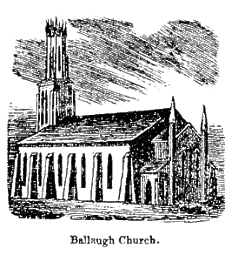 The
old church, which contained only 350 sittings, was 1½ miles from
the village, but a new one in the early style of English
architecture, with a lofty embattled tower of three stages,
strengthened with buttresses and crowned with pinnacles, and capable
of containing 700 sittings, has lately been erected, the expense of
winch, beyond the sum raised by subscription in the parish, was
defrayed by money collected in England for building churches for the
poor in the Isle. At the end of the village on the right, is the neat
residence of Cronk-ould, Mrs. M’Lean.—[For a
description of the soil, &c. from hence to Ramsey, see pages 35,
36.]
The
old church, which contained only 350 sittings, was 1½ miles from
the village, but a new one in the early style of English
architecture, with a lofty embattled tower of three stages,
strengthened with buttresses and crowned with pinnacles, and capable
of containing 700 sittings, has lately been erected, the expense of
winch, beyond the sum raised by subscription in the parish, was
defrayed by money collected in England for building churches for the
poor in the Isle. At the end of the village on the right, is the neat
residence of Cronk-ould, Mrs. M’Lean.—[For a
description of the soil, &c. from hence to Ramsey, see pages 35,
36.]
About two miles north of Ballaugh is seen the church of Jurby, on
very high ground, which affords an extensive view over the channel to
the opposite coast, and is about a quarter of a mile from the point
of land bearing that name. Pursuing your road, the village of Sulby
with its romantic glen is passed, a visit to which would diversify
the ride; up it is a fine waterfall which issues through a beautiful
natural bridge, and the scenery is magnificent. Crossing the river by
Sulby bridge, on the left there is a road to Kirk Andreas, Kirk
Bride, and the Point of Ayre, being the northern extremity of the
Island. Sulby is in the extensive parish of Lezayre,
which may be considered as the garden of the Island; the soil is
fertile, the produce is abundant, and amply repays the exertions of
the agriculturists; the sides of the mountains are prettily wooded,
and many residences belonging to Manks gentle men are passed—on
the left, Coolbane, R. Harrison, Esq., Ellenbane, F. Lamothe, Esq.,
Glentrammon, J. J. M. Corlett, Esq., Ballakillinghan, W.. Farrant,
Esq. ;—on the right, Staward, Capt. Bacon, Glenduff, L.
M’Whannel, Esq., and then the parish church of Lezayre, which is
in the gift of the crown, and is dedicated to the Holy Trinity; the
present incumbent is the Rev. Henry Maddrell.
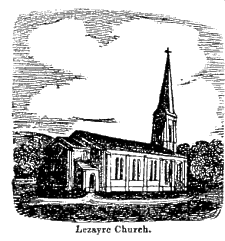 A
new church has recently been erected, which will contain 850
sittings, in the early style of English architecture, with a tower
surmounted by a spire. Beyond Lezayre is Milntown, the elegant seat
of Deemster Christian, after which you soon enter the town of
A
new church has recently been erected, which will contain 850
sittings, in the early style of English architecture, with a tower
surmounted by a spire. Beyond Lezayre is Milntown, the elegant seat
of Deemster Christian, after which you soon enter the town of
RAMSEY,
in the parish of Kirk Maughold; the town is irregularly built, but
the streets are wide, clean, and well paved, and great improvement
has recently been made by enlarging the market-place. The surrounding
country is picturesque, and in a high state of cultivation. The
neighbourhood is remarkable as the scene of numerous battles fought
between the Danes and Scots, when the latter had possession of the
Island. The harbour, accessible to vessels of 100
tons burthen, has been greatly improved by the construction of an
additional pier in 1830, the depth of water being thereby increased
more than three feet. The quay, on which is a light-house, is very
commodious, the bay is spacious, and the anchorage good. In the
centre of the town is a court-house
in which the Deemster for the northern division occasionally holds
his court, and the High Bailiff every Saturday. The parish church is
nearly three miles distant from the town, near Maughold head.
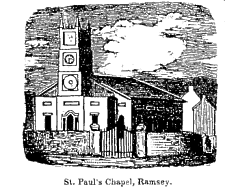 A
chapel dedicated to St. Paul is situated in the market-place, md was
erected in 1819, by suhscription, with a grant of £300 from the
Incorporated Society ror the enlargement af Churches and Chapels, in
consideration of providing free seats for the poor; it is a neat
edifice, with a tower, and contains sittings for 500 per sons;
the old ruinous
chapel just without the town is used now only as a burying place
for strangers. There is also a small chapel dedicated to St. Peter,
which is at present closed, and places of worship for Wesleyan and
Primitive Methodists, and Scotch seceders. The Grammar School was
founded by Mr. Charles Cowell. There are two National Schools, on Dr.
Bell’s system of education, for boys and girls, supported
entirely by voluntary contributions. There are several good inns in
the town, the principal one is Heelis’s Hotel, directly facing
the bay,—at which place packets between Glasgow and Liverpool
call several times a week.
A
chapel dedicated to St. Paul is situated in the market-place, md was
erected in 1819, by suhscription, with a grant of £300 from the
Incorporated Society ror the enlargement af Churches and Chapels, in
consideration of providing free seats for the poor; it is a neat
edifice, with a tower, and contains sittings for 500 per sons;
the old ruinous
chapel just without the town is used now only as a burying place
for strangers. There is also a small chapel dedicated to St. Peter,
which is at present closed, and places of worship for Wesleyan and
Primitive Methodists, and Scotch seceders. The Grammar School was
founded by Mr. Charles Cowell. There are two National Schools, on Dr.
Bell’s system of education, for boys and girls, supported
entirely by voluntary contributions. There are several good inns in
the town, the principal one is Heelis’s Hotel, directly facing
the bay,—at which place packets between Glasgow and Liverpool
call several times a week.
In passing through Ramsey, the antiquary who is
acquainted with the history of the Island, feels a wish that the spot
could be ascertained where good King Olave was assassinated by his
villainous nephews, and that a monument was erected to perpetuate his
memory. King Olave, may with great propriety be denominated the Manks
Justinian. He was educated at the court of Edward I., and was a
Prince of a peaceable disposition. Prior to the reign of Olave, the
natives were little better than savages, he did much to raise them on
a scale of civilization; and were the excellent deeds of that
excellent Prince fully known, every Manksman would cherish his memory
with respect and veneration, as one of the greatest benefactors to
his native Isle.
From Ramsey there is a very pleasant ride to Kirk Bride and Kirk
Andreas; the former is about five miles from Ramsey; the living is a
rectory in the gift of the crown, the present rector is the Rev. John
Nelson. The church is dedicated to St. Bridget, and contains 250
sittings. Near the road is a high mountain, surrounded with stones,
called Cronk-e-vowlan, a sepulchral tumulus, where
"in his narrow house,
Some warrior sleeps below."
In this parish is the Point of Ayre, the northern extremity of the
Island; the land is low, and the shoals, which extend to a
considerable distance from the shore, have occasioned many
shipwrecks. On it is a light-house
106 feet above the level of the sea, with a revolving light, showing
alternately a red and white colour, which attains its greatest
brilliancy every two minutes; the white light may be seen at the
distance of four or five leagues, but the red light is not visible at
so great a distance.
Nearly four miles from Ramsey is Kirk Andreas, a rectory in the
gift of the crown, the present incumbent is the Ven. Archdeacon Hall.
The church was rebuilt in 1802, and contains 650
sittings; in the interior is a handsome marble font, which formerly
belonged to Philip I. of France, and, being confiscated at the time
of the revolution, was presented to this parish by Mr. Corlett. Near
the entrance gate is an ancient cross, with runic inscriptions. On
the estate of Ballacurry, in the parish of Andreas, the property of
J. M. Christian, Esq., stands a fort, which was erected at the
commencement of the civil wars, with a view to protect the north of
the Island, in the event of its being invaded by the Cromwallians.
There are four noble bastions at the four corners, and it is
surrounded by a wet fossé. The internal square for the troops
to encamp upon is a fine level piece of ground sunk so much below the
bastions and curtains as effectually to secure those within from any
outward attack by fire arms. At the time when this earthen fort was
erected, one Capt. Sayle was the proprietor of the estate. A division
of the parliamentary forces, consisting of about 800 foot, under the
conduct of Colonels Duckenfield and Birch, landed on the Island and
passed by the place, where a number of the inhabitants were collected
together to defend themselves against the enemy. One resolute
Manksman was about to fire a cannon at the enemy, but was prevented
by another, on whose head the bump of cautiousness was more fully
developed, who came behind, seized him, and flung him away among the
crowd. The enemy passed along, the officers saying one to another, it
is only a heap of sand, it is not worth expending our ammunition upon
it. Capt. Sayle’s kiln, where he was drying his corn at the
time, was set on fire by an ill-disposed soldier, and that was all
the mischief done. From hence they marched through Sulby, went up
Bair-jiarg-Charrin, and passing over the mountains in a direct line
for Castletown. Some barrows have been opened in this parish, and
found to contain urns and other relics of antiquity.
On leaving Ramsey, you proceed along the road
towards Douglas, with the lofty mountain of North Barrule on the
right hand. After ascending the hill about a mile from Ramsey, by
taking the road along the shore to the left, and passing Folieu, and
the villas of Bell Vue and Lewague, you arrive at the rural and
antiquated Kirk of St. Maughold, situated in a spacious area
containing at least, three acres of consecrated ground, which was
formerly a sanctuary for criminals.
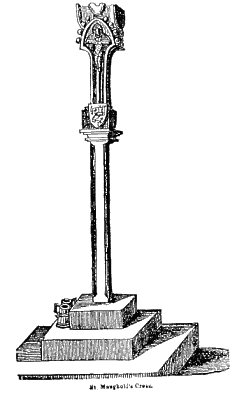
The ancient font, which is very large, evidently
made for the total immersion of the infant, has been removed from the
interior of the church and placed on one side of the entrance. In the
church-yard are numerous monuments, among which is a very handsome
one to the memory of Captain Hugh
Crowe, a native, and commander of several merchant vessels;
oppossite to the church-gate is a Danish cross, and near it a column
consisting of a circular shaft about five feet high, surmounted by a
cubic block of stone, on one side of which is sculptured a
representation of our Saviour on the cross, with the arms of the Isle
of Man beneath; on the opposite side, the Virgin and Child; on the
third side, a figure in the attitude of supplication, supposed to
represent St. Bridget; and the fourth side, which is totally defaced,
is supposed to have been a representation of St. Maughold himself.
The chancel windows of the church represent the only specimen of
tracery to be found in the Island. Mr. Allen, a protestant clergyman,
who fled during the persecution of Queen Mary, from the city of
Norwich, found an asylum in the Isle of Man. He was the first
protestant clergyman on the Island, and kept a school in Castletown,
and in the family there has been a regular succession of clergymen
from the days of Queen Mary to the beginning of the 19th century. The
descendants of Mr. Allen were Vicars of the parish of Maughold for
several generations. This information the writer had from the late
Thomas Allen, Esq., of Ballavarry.—The
Quakers or Society of Friends had a burial ground in this parish,
and formerly a distinct portion of the church-yard, which was not
consecrated, was appropriated to their use, yet there is no monument
or tablet to perpetuate the name of a single individual. It is,
however, many years since any of that persuasion resided in the
parish.
Maughold Head is a bold promontory, terminating in
a precipitous and lofty cliff, and forming the most easterly point of
the Island; on the summit are tiers of moss-cl-ad rocks. Under one of
these rocks is a fine-spring called St.
Maughold’s Well, which was formerly resorted to for its
supposed medicinal virtues. The water was imagined to derive
additional efficacy if drank sitting in the chair of the Saint.
Further on, at Ballaglass, is a waterfall surrounded by woodland
scenery, forming the highest and most picturesque cascade in the
Island : it arises from the obstruction of the rivulet Dhoon, on the
coast between the boundaries of Maughold and Lonan.
Passing on towards Laxey, Snaefell rears its venerable head and
invites the traveller to a glorious
view from its summit of the majesty of nature. It is deemed the
centre of the British Isles, and on a clear day affords a remarkable
and extensive prospect of the coasts of England, Ireland, Scotland,
and Wales, as from it can be seen the mountains of Cumberland and
Lancashire, in England; of Arklow and Morne, in Ireland; of Galloway,
in Scotland; and Carnarvonshire, in Wales. Beneath this stupendous
pyramid of nature are the romantic hills, vales, and glens of Mona,
beautifully interspersed with their woods, waters, villages, and
towns spread out like a map at your feet. On the summit of this
mountain the famous Cowley wrote his Poetic Vision, deploring
the miseries and calamities of civil war, without reflecting on the
quiet and serenity of the place on which he was.
"When I go," said the Earl of Derby (who was beheaded in the civil
wars) "to the top of
Snaefell, and see England, Ireland, Scotland, and Wales, I think
shame so fruitlessly to see so many kingdoms at once (which I think
no place in any nation that we know of under heaven can afford such a
prospect of,) and to have such little profit by them."
[actually he said it of S
Barrool]
 In
the church yard the first thing that attracts attention is a plain
tomb, railed in with iron, on which is the following inscription:
"Sleeping in Jesus: here Lyeth the Body of Thomas
Wilson, D. D., Lord Bishop of this Isle, who Dyed March the 7th,
1755, aged 93, and in the 58 Year of his Consecration. This Monument
was Erected by his Son Thomas Wilson, D.D., a Native of the Parish,
Who in obedience to the express Commands of his worthy Father,
Declines giving him the Character He so Justly Deserved. Let this
Island Speak the Rest." Bishop Hildersley, Phillips, Mason, and
Crigan are also buried in this church yard, where are many reliques
of great antiquity, amongst them is a stone cross with the following
inscription :—
In
the church yard the first thing that attracts attention is a plain
tomb, railed in with iron, on which is the following inscription:
"Sleeping in Jesus: here Lyeth the Body of Thomas
Wilson, D. D., Lord Bishop of this Isle, who Dyed March the 7th,
1755, aged 93, and in the 58 Year of his Consecration. This Monument
was Erected by his Son Thomas Wilson, D.D., a Native of the Parish,
Who in obedience to the express Commands of his worthy Father,
Declines giving him the Character He so Justly Deserved. Let this
Island Speak the Rest." Bishop Hildersley, Phillips, Mason, and
Crigan are also buried in this church yard, where are many reliques
of great antiquity, amongst them is a stone cross with the following
inscription :— The
old church, which contained only 350 sittings, was 1½ miles from
the village, but a new one in the early style of English
architecture, with a lofty embattled tower of three stages,
strengthened with buttresses and crowned with pinnacles, and capable
of containing 700 sittings, has lately been erected, the expense of
winch, beyond the sum raised by subscription in the parish, was
defrayed by money collected in England for building churches for the
poor in the Isle. At the end of the village on the right, is the neat
residence of Cronk-ould, Mrs. M’Lean.—[For a
description of the soil, &c. from hence to Ramsey, see pages 35,
36.]
The
old church, which contained only 350 sittings, was 1½ miles from
the village, but a new one in the early style of English
architecture, with a lofty embattled tower of three stages,
strengthened with buttresses and crowned with pinnacles, and capable
of containing 700 sittings, has lately been erected, the expense of
winch, beyond the sum raised by subscription in the parish, was
defrayed by money collected in England for building churches for the
poor in the Isle. At the end of the village on the right, is the neat
residence of Cronk-ould, Mrs. M’Lean.—[For a
description of the soil, &c. from hence to Ramsey, see pages 35,
36.] A
new church has recently been erected, which will contain 850
sittings, in the early style of English architecture, with a tower
surmounted by a spire. Beyond Lezayre is Milntown, the elegant seat
of Deemster Christian, after which you soon enter the town of
A
new church has recently been erected, which will contain 850
sittings, in the early style of English architecture, with a tower
surmounted by a spire. Beyond Lezayre is Milntown, the elegant seat
of Deemster Christian, after which you soon enter the town of A
chapel dedicated to St. Paul is situated in the market-place, md was
erected in 1819, by suhscription, with a grant of £300 from the
Incorporated Society ror the enlargement af Churches and Chapels, in
consideration of providing free seats for the poor; it is a neat
edifice, with a tower, and contains sittings for 500 per sons;
t
A
chapel dedicated to St. Paul is situated in the market-place, md was
erected in 1819, by suhscription, with a grant of £300 from the
Incorporated Society ror the enlargement af Churches and Chapels, in
consideration of providing free seats for the poor; it is a neat
edifice, with a tower, and contains sittings for 500 per sons;
t